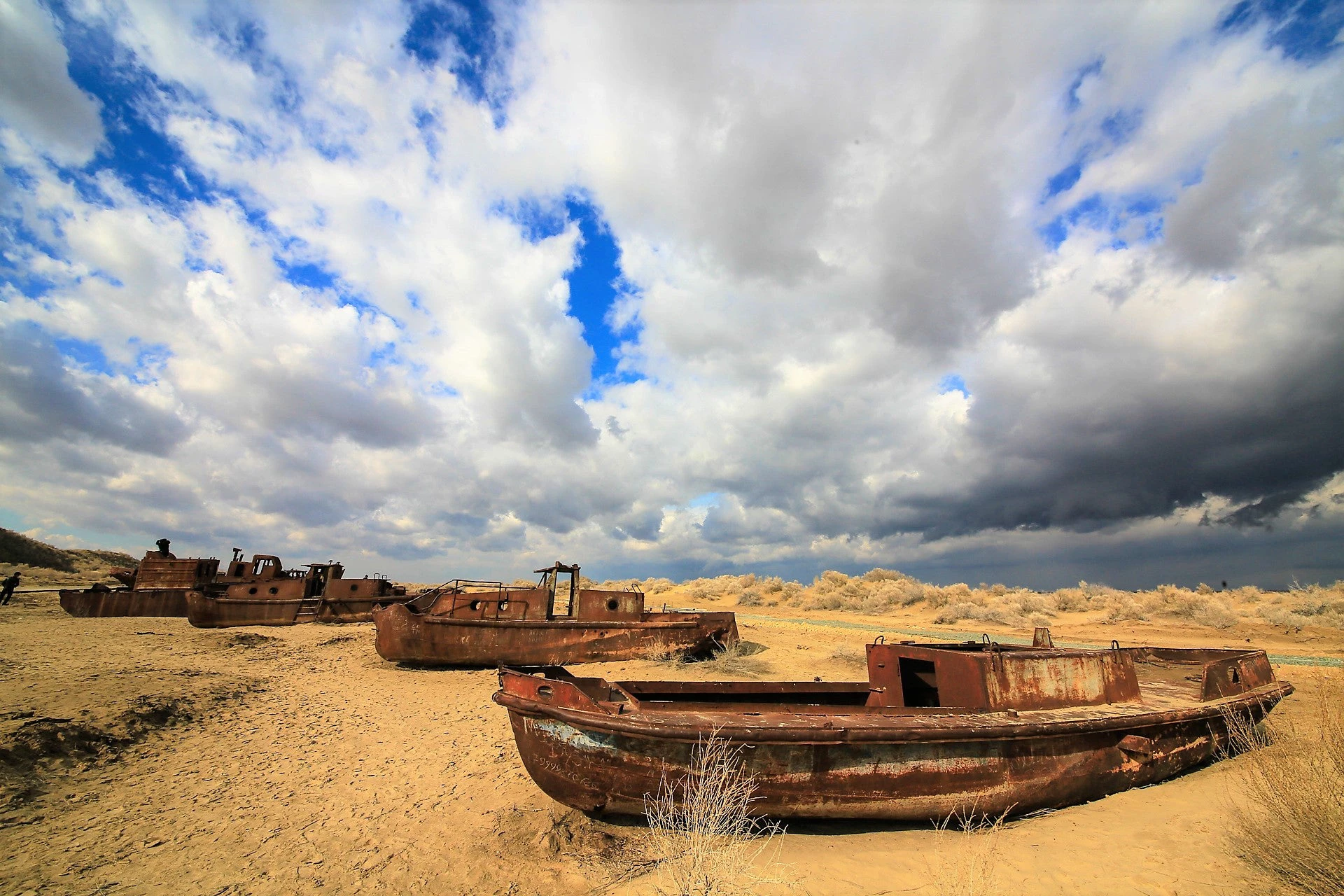 Aral Sea. © Yuriy Korsuntsev/World Bank
Aral Sea. © Yuriy Korsuntsev/World Bank
I started reading about the Aral Sea disaster in 1989 ahead of my first visit, as a student and tourist, to Uzbekistan, then still a Soviet republic. In Karakalpakstan, the autonomous republic in current-day Uzbekistan, the Aral Sea has all but disappeared. Where fishing communities once thrived, all that remains is a scarred, desert landscape. Rusted ships are perched precariously on piles of sand and salt, along with a potent, unhealthy mix of toxic pollutants from industrial agriculture.
Celebrated in its heyday as the world’s fourth-largest lake, the Aral Sea shrunk dramatically after the two major rivers that fed its waters were diverted in the 1960s to irrigate cotton and rice. As the water was drained and diverted, coastlines receded, remaining waters became saltier and evaporated, killing off the fish that communities had relied on for decades. The land became more and more degraded, transformed into a desert where plants were unable to grow. Climate change made the situation worse and in May 2018, a major sandstorm swept across Nukus, the capital of Karakalpakstan, covering the area in a layer of toxic dust and salt. People struggled to breathe; air transport was affected along with agriculture and cattle breeding, a key industry in the area.
The shrinking of the Aral Sea is viewed as one of the worst environmental disasters of our time. On the Kazakhstan side, thanks to a dam funded by the World Bank, the Sea is slowly coming back, though to only a small fraction of its original size. On the Uzbek side, Karakalpakstan is taking strong measures to adapt and make the land more resilient. One example is the planting of Saxaul, a sand- and salt-loving tree species. These trees act as a barrier from the sand with the goal of stabilizing the soil and preventing the toxic sandstorms that have plagued the area and increased health problems for the community. Almost incredibly, we will see a spiny forest grow where there was once a sea.
Through a project called the Climate Adaptation and Mitigation Program for the Aral Sea Basin (“CAMP4ASB”), the World Bank has been supporting both Tajikistan and Uzbekistan in their climate mitigation and adaptation efforts in the former Aral Sea. The $38 million project includes credit lines for small- and medium-scale agricultural and agribusiness investments that typically save water and energy while supplying better products to the market. Up to date some 15,000 people benefited from investments that include the restoration and rehabilitation of degraded land , conservation agriculture and the diversification of crops, including growing salt and , drought, pest and disease-resistant crops for income generation. An additional US$19 million from the Green Climate Fund is being added to expand these efforts to the poorest and most vulnerable populations in Tajikistan and Uzbekistan, primarily through community grants.
The Central Asian Drylands, including the Aral Sea, are one of the most rapidly degrading areas in the world. Climate change and land degradation has affected the economy and quality of life. Desertification, pollution and the resulting loss of arable land has hurt the rural poor who directly depend on the land for their livelihoods and survival.
We are also developing an ambitious program in Central Asia for Resilient Landscapes – we call it RESILAND – to make lands less vulnerable and to promote climate-resilient integrated landscape management of drylands and mountain ecosystems. Among other benefits, restoring the degraded landscape will help to reduce the impact of flooding, land and mudslides in the region. Other activities financed by the project include terracing, agroforestry, and bioresources engineering solutions plus more effective watershed management.
The entire region is working more closely to address degraded lands and in June 2018, eight countries from Central Asia and the Caucasus adopted what is known as the Astana Resolution and committed to restoring 2.5 million ha of degraded forests and landscapes.
The World Bank is also playing its role and in January launched a new Action Plan on Climate Adaptation and Resilience. Between 2021-2025, the Bank will increase direct financing for adaptation globally to $50 billion – twice as much as what we have done between 2014 and 2018. This work will support, among other things: better weather and hydrological data; investments in climate-smart agriculture, risk mitigation instruments and funding the protection of landscapes, building more resilience in nature so that nature can help us. We will also increase support for Ministries of Finance and Planning, focusing on the poorest populations – those that are most vulnerable to climate change.
Much more needs to be done, but we are headed in the right direction, including with such unusual activities as turning the depleted Aral Sea into a forest.



Join the Conversation